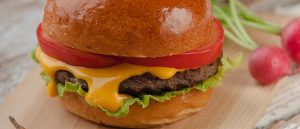
The Mitzvah:
A milk and meat mixture cannot be cooked together in one dish, eaten nor can any benefit or profit be derived from such a mixture (Exodus 23:19, ibid 34:26, Deuteronomy 14:21). The stringency of their separation carries a rabbinical edict forbidding the eating of any dairy-meat mixture (even where not cooked together) and instituting a time period to elapse after meat prior to partaking of a dairy dish.
A key feature of a kosher kitchen is the laws of Basar b’Cholov, meat and milk. Separate utensils for meat and dairy products are central to Jewish cuisine.
A divine decree that defies human comprehension, this mitzvah is clearly a novelty because, unlike other non-kosher products, each food is independently permitted. It is only prohibited as an integrated cooked mixture.
Why should milk and meat require such separation? What symbolic depth lies within the cooked mixture of these two foods that requires such an extensive level of separation?
Life brings with it darkness, confusion and moral ambiguity in its wake. Good and bad freely intermingle. And it is therefore up to every individual to undertake the process of “birrur, clarification” – namely that of charting a path through life, whereby a person methodically sifts the “good” by extracting it from the “bad” that is then rejected and left behind.
Of course, it is the Jewish people’s status as “the chosen people” as Torah adherents that facilitates this process. (Interestingly, this concept finds expression in the Shabbat laws of Borer, “selection” from an assortment of mixed items. (See Mishnah Breruah, Orach Chaim 319) A person should only extract the “good” (i.e. the object he desires) from the “bad” (i.e. that which he does not select), colloquially called “Ochel Mi’toych P’soy’les, the food from the worthless, bad or refuse” but not choosing the “bad” from the “good”).
The laws of Basar b’Chalav captures the selection of “good”, and having done so, cautions us to prevent it intermingling once again with the “bad”. The superior component of the “flesh” and blood of a mother of an infant is elected for the production of life-sustaining “milk” to feed her young. Remarkably, the lactation of the mother provides the natural, nutritious fluid – the ideal nourishment for her young whose life has just begun. Indeed, a women’s menstruation cycle is disrupted as the “blood becomes turbid and changes into milk” (Talmud, Niddah 9a).
Thus, milk symbolically represents the stage “after” birrur has taken place, once it has been elevated from the remainder of man’s bodily components – namely the “meat” of the blood and flesh. The Sefas Emes (Emor 5659) explains how once there has been a selection of “good” and milk has been procured, safeguards are constructed to ensure that they remain separate and that this does not regress back to its “bad” (read: unrefined) state. The main prohibition, of cooking milk and meat together, is the process whereby one flavor becomes absorbed within the other (Chullin 108b). This sees the joining of different substances into one entity (See Maharal, Nesiv HaShalom Ch.3 the reason that a cooking pot is the symbol of peace (Berachos 56b) is because the ingredients join to form one dish).
This model finds expression in the journey of the “chosen nation” from Egypt whose base animalistic tendencies is synonymous with “meat” (See Exodus 16:3 “we [Israelites] sat by the pot of meat” (Shemos 16:3); see also Ezekiel 23:21). Meat is the epitome of physical desire – corresponding to the Egyptian basest instincts. Their final destination, by contrast, was the Holy Land, the land “flowing with milk and honey” (Exodus 33:3).
But to get to that state, they first had to shake off the Mixed Multitudes’ influence, the residue of Egyptian ideology, and their unsanctified cry “Who will feed us meat?” (Bamidbar 11:4). Rather than focusing on meat, the foodstuff of physical indulgence, they had to embrace the ideal of spiritual food from heaven, the manna with no waste “bad” element to it, a food symbolically compared to the infant suckling “milk” from its mother (See Talmud, Yoma 75a).
And to become the elevated, “selected” nation of G-d, they underwent a transition from Pesach, the festival celebrating the exodus from Egypt, with its associated mitzvah of eating “meat” of the Paschal Lamb (Exodus 12:8), before arriving at Mount Sinai. There is custom on Shavuos, the festival that commemorates the giving of Torah, to eat “dairy products” (Rama, Shulchan Orach 494:3). This marks the culmination of the “selection process”. They had attained the superior state of milk leaving the meat behind – in-other-words, sundering all links with the “bad” Egyptian values to embrace the “good” and beauty of Torah law. Typically, a time gap ensues after eating meat before consuming milky products (Customs vary between one, three to six hours).
Thus, the mitzvah of Basar b’Cholov symbolically stresses the chosen-ness of a Jew by urging him to conduct his life with an eye of birrur, “clarification” of what is “good” (milk) that is to be selected and what is “bad” (meat). Thereafter, he cannot afford to regress or to assimilate – namely to eat, cook or derive benefit – these discarded ideals because he has now embraced the magnificence and “milk” of the Torah. Text Copyright © 2006 by Rabbi Osher Chaim Levene and Torah.org.


